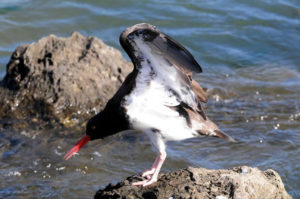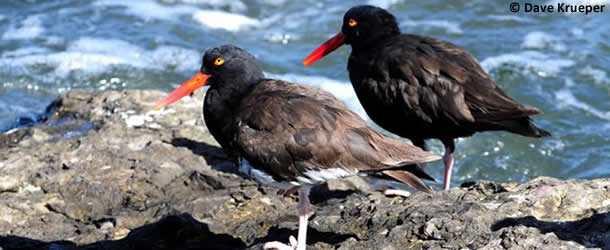By Eduardo Palacios
The American Oystercatcher (Haematopus palliatus) is a large and charismatic shorebird that lives on sandy beaches, islands, and coastal wetlands of the temperate and subtropical zones of the Western Hemisphere. The Pacific population, recognized as a distinct subspecies, H.p. frazari, is resident on both coasts of the Baja California Peninsula as well as the entire west coast of mainland Mexico. Recent censuses suggest that there may be as few as 2,500 individuals of this population, raising considerable concern. The breeding range is restricted to northwest Mexico, particularly the states of Sinaloa and Baja California Sur. Even more alarming is the fact that coastal development and hybridization with Black Oystercatcher (H. bachmani) put this subspecies at risk of extinction.
The working group “Ostreros” [Oystercatchers] was established at the 2012 annual meeting of GANO, Grupo Aves del Noroeste [Bird Group of the Northwest of Mexico]. In coordination with the American Oystercatcher Working Group from the Atlantic Coast of the U.S. they began a research and conservation project for the American Oystercatcher in northwest Mexico. The goal is to promote research and conservation of American Oystercatchers and their habitats in northwest Mexico by coordinating studies and conservation actions.
By monitoring reproductive success and using tagged birds, this project will provide critical information for conservation, including about site-fidelity to breeding and nonbreeding areas, dispersal movements and survival rates of adults and juveniles.

In 2013 the oystercatcher working group monitored a sample of the breeding population (303 pairs) at ten sites in northwestern Mexico. Biologists found seventy-two nests, but they contained only 29 chicks. The average clutch size was 2.0 eggs per nest (n = 57 nests), well below the average population of oystercatchers on the Atlantic (2.7 eggs per nest). They were able to band five of the 29 chicks. Nest failure was caused by high-tide flooding and predation (coyotes, gulls and crows) probably facilitated by human disturbance at nesting sites. Of the 913 individuals observed, two-thirds had a territory and a mate and another third were “floating” individuals without territory or mate. Researchers concluded that the availability of suitable nesting sites is a limiting factor for the population of oystercatchers in northwestern Mexico.
Since the conservation of this and other shorebirds in the region seems to be a matter of habitat conservation and protection, we need to identify the main areas of reproduction and restrict human-caused disturbance, as well as identify the important foraging areas for the species. Information on abundance and distribution, limiting factors, habitat requirements, threats to habitat, and conservation opportunities will be needed to support informed decisions by natural area managers and decision makers.
To learn more about this effort, contact Eduardo Palacios.

